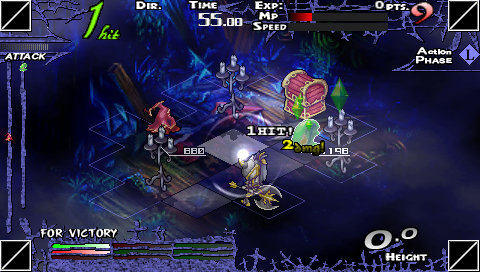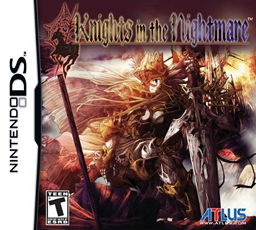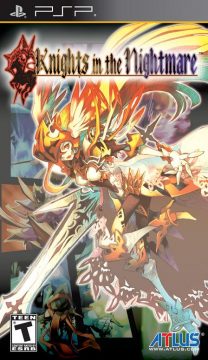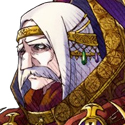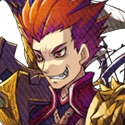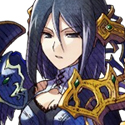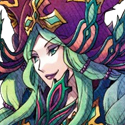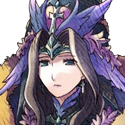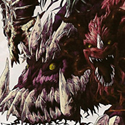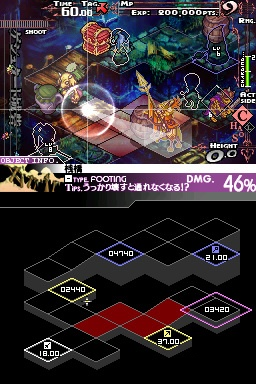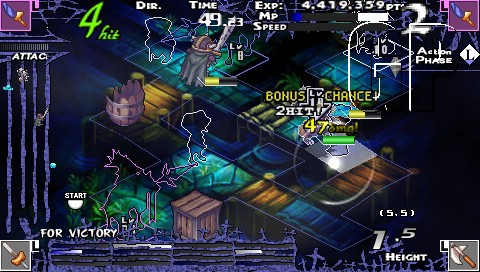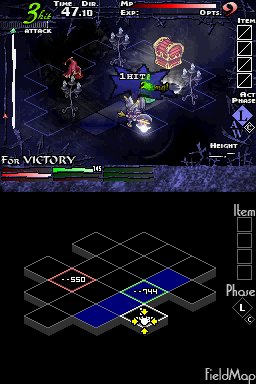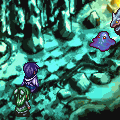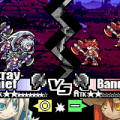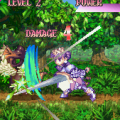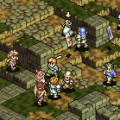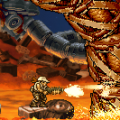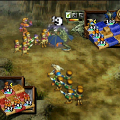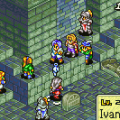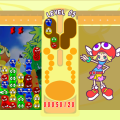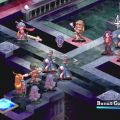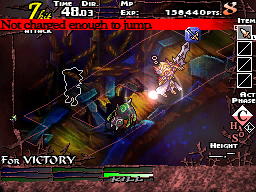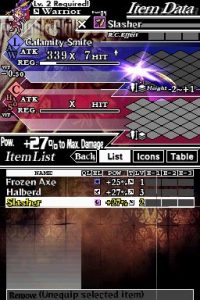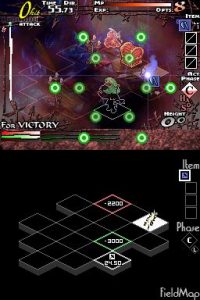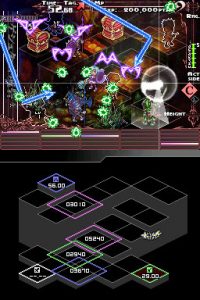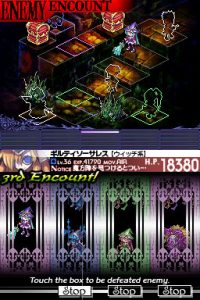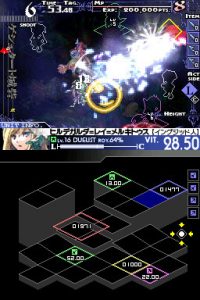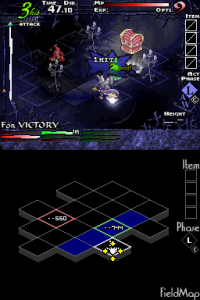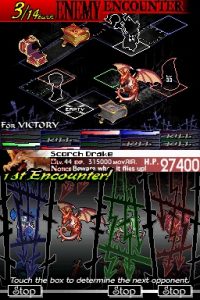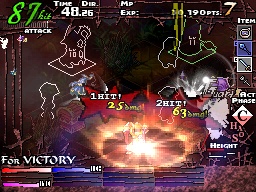As Yggdra Union and Riviera did long before it, Knights In The Nightmare (hereafter abbreviated as KITN) takes the concept of a strategy RPG and completely flips it upside its head, far surpassing even the other two games in uniqueness and execution. It is what can only be described as the bastard child of a grid-based SRPG like Tactics Ogre and a bullet hell shoot-em-up. It’s an utterly bizarre combination that works far better than you would think.
The kingdom of Aventheim is slowly falling prey to monsters and internal political squabbles. The mighty king that ruled it is dead, and his legions of knights are being slaughtered trying to defend their land from the monsters that now roam free. A young, mysterious valkyrie by the name of Maria sets the king’s soul free, having stolen it from the castle, and fights alongside him, raising the souls of the king’s dead knights in order to bring peace to the land before all is lost. Unfortunately for them, the ones in the castle who grew to hate the king and the monsters seem to be working together, and will fight tooth and nail to keep themselves on the throne. To further complicate matters, there is fanatic racism against the Tiamat people, a race of people with dragon-like attributes, and their suffering only leads to further pain for everyone.
There exist two official spellings for most of the characters’ names, some of them having even three. Sting gave out its own set and when Atlus localized the game for America, re-translated them. This has caused great divide and controversy online, and for the sake of simplicity and familiarity, this article will be using Atlus’ versions.
Characters
King Wilmgard
The recently deceased king of Aventheim. Known to many as the ‘Lion Heart King’ for his kindness to his citizenry and his troops as well as his immense physical strength, often fighting alongside his knights on the battlefield. Was last seen alive in the town of Regnieburg searching about for signs of monsters and invasion. His soul was resurrected by Maria and given form as a light known as the Wisp, which has the mysterious ability to give life again to his fallen knights, albeit briefly.
Maria
A valkyrie who broke into Aventheim and stole the container Wilmgard’s soul was sealed in, freeing him so he could help bring his country back from the brink of ruin. Don’t let her rough looks fool you; she’s honestly quite timid, has a huge guilt complex, and can be a real sweetheart at times. Seems to have a hidden agenda. Has no restrictions on what weapons she can use in combat.
Cardinal Capehorn
Aventheim’s cardinal, and the one who hated Wilmgard the most. Uses and abuses everyone under him in order to get his way and stay in power now that the king is gone. The only one he seems to genuinely care about at all is his granddaughter, Piche.
Leonil
One of Capehorn’s highest ranking generals. Only really in it for the thrill of the kill, and gets easily pissy when told to fight or kill people he finds weak. A bit of a lazy-ass and quite a bit crazy. Often seen fighting with Aquina.
Aquina
Another one of Capehorn’s highest ranking generals. An extremely racist, cold-hearted, apathetic sniper who is often arguing with everyone, especially Leonil. Only seems to place faith in Capehorn.
Yelma
An insane mage with an incredible hunger for power. Though rescued by Capehorn from her bloodline and made one of his generals, she has zero respect for him and does as she pleases. A disgusting manipulator who obviously only loves herself.
Algiery
A spy sent in to seduce and win over Wilmgard so he would side with them, but made the mistake of falling in love with him and getting married. Became the leader of the Sixth Order of Aventheim’s knights. When Wilmgard died, Capehorn told everyone she had done him in, and she’s been on the run since.
Melissa
A rather fickle and semi-affable woman who is one of the main villains. She’s the one boss who shows up multiple times for you to beat in and send packing who nevertheless comes back for more as their ambition is too great, blinding them. May or may not suffer from Attention Deficit Disorder.
While Riviera is cute and more lighthearted than serious, and Yggdra Union is darker but still decidedly cutesy, KITN is far darker in tone in every way. The art, while sharing designers between games, is a great deal more gritty and detailed, using lots of stern faces and darker colors for characters, monsters, and maps. The music is much more frantic and serious, the battles are faster paced and more active, and the storyline is one constant gut punch after another. Every character, of which there is over 120 of, a vast majority of that playable, is given unique personality, background, a unique combat title, and their own varied appearance. These are expounded upon in the pre-order bonus book given out by Atlus and other various Japanese guides, and they’re quite interesting. Until you remember most of these people are dead already or will die, all of which you’ll see the deaths of, lending the game its somber, heartbreaking tone throughout.
The game itself is controlled mostly with the stylus with all the action happening on the upper screen. You control the Wisp with the stylus, dancing freely across the isometric battlefield. Units remain outlined only in wireframe until you touch them, at which point they charge up to attack. You can charge it to minimum or maximum range then let go of the screen to attack, hitting any map objects or enemies in their way. This causes gems and materials to be released, which you can gather to charge an MP gauge. For each one charge in it, you can use skills attached to weapons to unleash a strong attack at full attack range charge to cause great damage to anything in the attack area. This is the only way to really kill or damage enemies or destroy map objects, as regular attacks mostly throw out gems to be gathered. You can also save up attacks at full charge to be released via a light tap for when stuff gets closer in range.
There are two main ‘phases’ you can freely switch between, called Law and Chaos. Law shades the battlefield blue, while chaos shades it red. Each phase changes the attack range for each unit and has a limited amount of gems to be found, which means once enemies aren’t giving you any more, you should switch and collect more on the other side if possible. Most weapons and skills also only work under one specific phase, so it’s best to bring variety in with you. Though caution is needed as skills require a certain level to have been reached before you can use it. Some exist that can be used regardless of phase, but they’re usually high leveled and hard to find. Weapons with skills on them break after a certain amount of uses. You can prevent this by either strengthening weapons using the materials found in battle or by fusing duplicates together. Effects can be stacked as well, allowing you to create truly monstrous weapons if you desire. There’s also the usual elemental system that works its way into most RPGs, which determines how effective a skill will be at working, and units themselves also have innate elements that factor in.
Battles have a limit to how many phases they can go, and each phase is timed. You have 60 seconds to play a phase and it mostly drops down when you’re charging units. While you’re fighting, you might also want to be trying to destroy objects on the map to gain recruiting items, which allow you to permanently recruit units in the game by taking the item and giving it to them during the battle. The game can be beaten easily enough with the default units given on each map, but having a few of each class is preferable, as you can replace weakened ones between phases. You can also swap out weapons, skills, and recruitment items before each phase, though you have a limit of four per phase, so plan carefully.
To win, you have to fill in a bingo row or column on the bottom of the top screen, and enemies are chosen before a new phase in a roulette that match color to the bingo rows. Diagonals count. The roulette is slow enough, allowing for enough manipulation if you time it right to end battles quickly. Boss fights usually consist of one large enemy you have to kill by the time all the phases are up instead of going for a bingo.
While you’re doing this, enemies attack by spewing out bullets shaped anywhere from typical shoot-em-up ammunition fare to spider webs, snakes, bats, swords, claw marks, to rays and anything else in between. Getting hit results in time being subtracted form your limit alongside various other annoying effects, such as stylus controls becoming reversed for a short period.
It’s best to watch out for your units’ vitality. Each unit has a certain amount of it, and it drops a bit every time you activate them to attack. If it drops to 0, they are permanently removed from the game. You can only restore vitality by leveling a unit up or by combining them in a process known as transoul. You take one unit and permanently remove them from the game, sacrificing their spirit to power up another and restoring vitality, leveling up, and raising level cap of the unit that received the soul. The higher a unit’s level and loyalty, the higher the power is received by the taker. An interesting aspect to this is that race and relationship play a factor into this, so it’s important to listen to the game world and pay attention to who likes (or hates) who in what ways if you really want to maximize potential. You can also just get rid of any unit you don’t like at any time, receiving an item pertaining to their class in return. Thankfully, there’s also some free leveling maps you can use to farm experience, items, and weapon upgrade materials, so you won’t run out if you’re paying attention.
The bottom screen has a basic wireframe map that shows the positioning of your units and how much vitality they have left as well as enemy positions and their remaining HP. They are shown as a colored outline on the tile their on and the color represents their element. It also helps you keep track of map height, which can help or hinder your attacks’ ranges. You’ll barely be paying attention to this, though, as it’ll soon become second nature to pay attention to the top and play from there for the most part.
There are seven classes in the game, and each character will belong to one. Archers are all male and use bows, which have a one square law attack and a multi square chaos attack, both at long range. They attack facing left or down. Duelists are all female and use swords, which have a sword shaped law attack and a jump that moves them up by one square in what direction they’re facing for their chaos attack. They attack facing up or right. Hermits are all female and use daggers, with both their law and chaos attacks sweeping to their sides. They attack facing left or down. Lance Knights can be either gender and use lances, which have a straight line law attack and a fatter 2×3 chaos attack that causes them to jump forward. They attack facing any direction. Priestesses are all female and use bells and maces, with a sweeping T shaped attack for law and a trap setting attack for chaos. They attack facing left or down. Warriors are all male and attack using axes, which have bursting line attacks for law and a bursting spread forward for chaos. They attack facing up or right. Wizards are all male and use staves, which can set up a trap like the priestesses on law and an explosive burst on chaos. They attack facing left or down. The only unique one is Maria, who is listed as a Valkyrie, and can attack using any weapon and uses large jumping and sweep motions, and has a broader directional range.
It sounds like a lot, and there are many intricacies that you’ll find hidden in it, but it’s also surprising how fast you get the hang of it all. There’s a full tutorial section on the title screen full of newbie tips with hands-on instruction, more in depth tutorials, and advanced tips that you can read or re-read at any time. By the time you’ve played a few maps, you’ll be adjusted enough to play quite well. It’s also strangely addictive despite the somber tones and one of the most unique takes on the genre to come out ever, trumping Sting’s previous output by miles. If you can sit yourself down with it enough to get the hang of it, you’ll find yourself rewarded with an incredible experience on every level.
Sting ported KitN to the PSP in 2010 in both Japan and America. Very little was changed from the DS version. The graphics are are a bit nicer, though the upgrade isn’t as noticeable as it was in Yggdra Union, and the music is of slightly higher quality. The only real strong change to it was the inclusion of being able to play through it as Princess Yggdra, who just replaces Maria in story and combat. It was a path that was cut from the DS release due to time constraints, but not very notable otherwise. Yggdra’s attacks are almost all the same as Maria’s; they didn’t even try making her truly unique to play as. There is a short animated opening like cutscene but that’s it as far as new scenes go. There are no new recruitable characters, no special bosses, and no new music. There’s only one new item in Yggdra’s Path and it has the same function as one of Maria’s plot items. The controls are harder to use as it’s mostly controlled with the analog nub. It comes off as clunky and unresponsive, especially if you’ve played the DS version beforehand. There’s an option to change control speed but it doesn’t help too much. No story bits are changed nor are they expounded upon at all. There’s honestly nothing much to recommend anyone here unless you don’t own a DS and don’t plan on buying one anytime soon.
Dept. Heaven – Or how KitN is related to both Riviera and Yggdra Union
KITN is Episode IV in a game series called Dept. Heaven, of which Riviera is Episode I and Yggdra Union is Episode II. They’re loosely connected, and most of the info you’ll find connecting them online will be translated on various fansites instead of the games themselves, but dedicated fans will be able to spot the bits linking them with a couple playthroughs each. Little details are known about Episode III, which was last planned to be an MMORPG of some kind. Even less is known about the next game in the series, Yggdra Spiral, which is designated as Episode IX and was supposed to be done by the end of 2010, but no info exists other than a few preliminary sketches.
It should be noted that the episode numbers do not indicate story or game order but how unique the game itself is. With three already increasingly bizarre games under their belt, one can only wonder what a jump from IV to IX will be like.
Screenshot Comparisons
